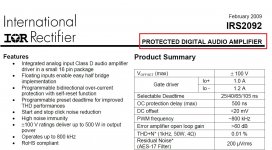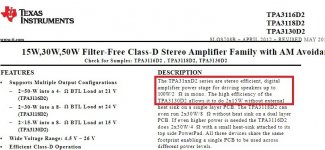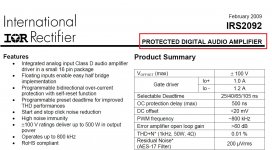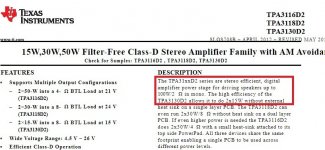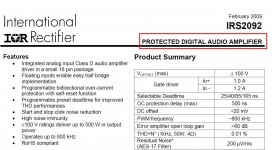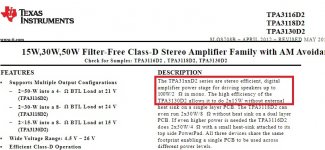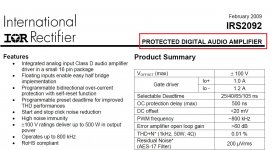https://www.diyaudio.com/community/...ss-d-is-class-ab-class-a.388305/#post-7072482I agree... though class D seems destined to overtake bipolar devices with GaN mosfet devices appearing in modules as per below. With user selectable slew rates between 25,000 to 100,000 volts/usec of the device indicated some extraordinary engineering seems necessary to realize such abilities. In other words no ordinary engineering. The results can go far beyond that suggested by simply doubling the PMW frequencies.
https://www.ti.com/lit/ds/symlink/lmg3410r050.pdf?ts=1657888627794&ref_url=https%3A%2F%2Fwww.ti.com%2Fproduct%2FLMG3410R050
Class D amplifier is not digital. It use PWM but also use negative feedback.
Distortion only can not tell how good the amplifier. At least you should measure IM distortion.
Attachments
Infineon’s claim to the “digital” Class D amp?Infineon’s claim to the “digital” Class D amp?
“The MA12070 features an embedded digital power management scheme. The power management algorithm dynamically adjusts switching frequency and modulation to optimize power loss and EMI across the output power range.”
“The MA12070 features an embedded digital power management scheme. The power management algorithm dynamically adjusts switching frequency and modulation to optimize power loss and EMI across the output power range.”
PWM is a digital signal. It is not an analog signal.
Attachments
Then you may need to give it to all class D amplifier chip manufacturers.Ohh, I often write to manufacturers about errors in datasheets.
Most modern datasheets have a link somewhere where you can report errors.
Not just names, sometimes graphs are clearly wrong.
They always reply and thank me.
Everybody makes mistakes, in this case everybody can see it is wrong.
Note that the guy who is tasked to write a datasheet is often not the guy who designed the part.
He is busy designing more parts ;-).
Example: https://www.ti.com/feedbackform/techdocfeedback?litnum=SBOS901B&partnum=OPA1655
Jan
Tell them that class D is not a digital amplifier.
Including Infineon, Texas Instruments.‘
Attachments
It is a hard life when the world is against you. Cheer up LJM!
PWM is a digital signal. It is not an analog signal.
This isn't correct - I give explanation here : https://www.diyaudio.com/community/...igital-audio-player-exist.380760/post-6894283
You know LJM, it is one thing to understand the need for marketing to people who are not as educated as you and think that if it is digital it must be great.
But people like you who are educated in these things should not fall for that and understand that PWM is clearly an analog process.
Don't embarras yourself.
Jan
But people like you who are educated in these things should not fall for that and understand that PWM is clearly an analog process.
Don't embarras yourself.
Jan
thank you. But I always like to stay in the position of a few people.It is a hard life when the world is against you. Cheer up LJM!
Of course, most of the time I'm no different from you. But I will ignore these same places. I pay more attention to different places.Because of differences, we can make faster progress.
If you have measured DAC. For example, the digital signal of 192K DAC.This isn't correct - I give explanation here : https://www.diyaudio.com/community/...igital-audio-player-exist.380760/post-6894283
You will find that it has the same shape as class D.
Infineon and Texas Instruments also think so.
Attachments
No.If you have measured DAC. For example, the digital signal of 192K DAC.
You will find that it has the same shape as class D.
Infineon and Texas Instruments also think so.
Manufacturers datasheets use fashionable marketing terms in calling their amplifiers digital. They perfectly understand that class-D is not, by definition, digital. You should as well.
If you believe the opposite, could you explain where is Digital to Analog Convertor in every class-D amplifier.
It doesn't matter what any documents indicate. The only thing digital is a digital file, everything else is analog, taking the shape of some variant square wave, or otherwise. In other words for any measurable/viewable signal there is no discontinuity in time or amplitude for a wave shape to be considered a digital representation. Taken the other way, an analog signal undergoing a A/D conversion is converted to a digital representation without time or amplitude variance. Looking like a square wave doesn't conclude a signal to be digital. Nothing physical can go from one amplitude to another in zero time. Physical waveforms cannot be described in absolute digital terms.
Last edited:
I remember (long time ago!) when I met Barrie Gilbert at an ADI seminar.
At the seminar he introduced the AD844/846 current conveyor ICs.
After the introduction he kept calling them opamps, so afterward I asked him why he didn't refer to them as CCs.
His reply: "If we would do that, they wont sell. Everybody knows opamps!"
Jan
At the seminar he introduced the AD844/846 current conveyor ICs.
After the introduction he kept calling them opamps, so afterward I asked him why he didn't refer to them as CCs.
His reply: "If we would do that, they wont sell. Everybody knows opamps!"
Jan
Any one-bit DAC realizes the analog multiplication of the input PWM signal (quantized amplitude, continuous time) with its analog reference voltage.
A class D output stage realizes the analog multiplication of the input PWM signal with the power supply voltage (continuous time and amplitude, ie. analog).
People who forget this make "digital amplifiers" which are really one bit DACs drawing a lot of current from their reference voltage. So they have between 6dB and 0dB power supply rejection.
A class D output stage realizes the analog multiplication of the input PWM signal with the power supply voltage (continuous time and amplitude, ie. analog).
People who forget this make "digital amplifiers" which are really one bit DACs drawing a lot of current from their reference voltage. So they have between 6dB and 0dB power supply rejection.
If you have measured DAC. For example, the digital signal of 192K DAC.
You will find that it has the same shape as class D.
Never seen a continuously quantized-in-time signal going into or out of any of my DACs. Did you read my link incidentally?
I understand the principle of PWM.You know LJM, it is one thing to understand the need for marketing to people who are not as educated as you and think that if it is digital it must be great.
But people like you who are educated in these things should not fall for that and understand that PWM is clearly an analog process.
Don't embarras yourself.
Jan
I think it can be called a digital amplifier. This is no problem.
If someone understands the principle of ADC. It's basically the same. Convert some analog signals into square waveforms. Then convert the PWM square waveform into a circular waveform. Through LC filter.
Analog amplifier has no conversion process. So in order to distinguish them. Digital amplifier is a good name.
But if you think they should be called something else.
Then you can give him a name. As long as others remember it.Such as PSU amplifier
Last edited:
I think this is a picture of Photoshop.How about this?View attachment 1075712
It doesn't make sense.
Yes. So Infineon. Texas Instruments are all liars.I remember (long time ago!) when I met Barrie Gilbert at an ADI seminar.
At the seminar he introduced the AD844/846 current conveyor ICs.
After the introduction he kept calling them opamps, so afterward I asked him why he didn't refer to them as CCs.
His reply: "If we would do that, they wont sell. Everybody knows opamps!"
Jan
Why should we make tpa3116 3255 ma12070
- Home
- Amplifiers
- Class D
- Performance ranking of CLASS D power amplifier MOSFET.

